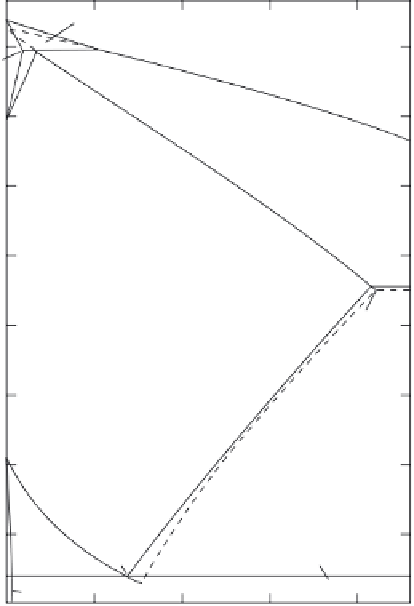Civil Engineering Reference
In-Depth Information
microstructure of steel is inherently heterogeneous, generally consisting of
grains (or 'phases', considered to be homogeneous in physiochemical
nature), dislocations, GBs, precipitates, and lattice defects. Figure 5.1 pres-
ents a portion of the equilibrium phase diagram of the Fe-C system under
atmospheric pressure (Chipman, 1972), which illustrates the thermodynam-
ics of three main phases in carbon steel, i.e., autensite (
), and
cementite (Fe
3
C), as a function of temperature and C content. Note that
equilibrium phases tend to form when there is suffi cient time to allow dif-
fusion of atoms and molecules. In many cases, the processing of steel may
include quenching or application of mechanical stress, which leads to the
formation of non-equilibrium phases such as martensite (
γ
), ferrite (
α
). For steels with
a signifi cant amount of alloying elements (e.g., stainelss steels), their micro-
structure may include many phases other than
α
′
γ
,
α
, and
α
′
(Lo
et al.
, 2009).
1527°
1538°
L +
δ
1495°
L (Liquid)
1500
0.53
0.09
δ
0.17
1400
1394°
L +
γ
1300
1200
γ
(Austenite)
1154°
1148°
2
.
08
2
.
11
110 0
1000
911.5°
900
γ
+ C
γ
800
+ Fe
3
C
α
+
γ
0.68
769°
α
+ C
738°
α
0.77
727°
700
0
0.5
1.0
1.5
2.0
2.3
Carbon (wt%)
5.1
Portion of the phase diagram Fe-C relevant to carbon steel.
Metastable
-range and system Fe-Fe
3
C shown by dashed lines.
Curie temperature dotted (adopted from Chipman, 1972).
With
kind
permission
from
Springer
Science
and
Business
Media.
γ




Search WWH ::

Custom Search